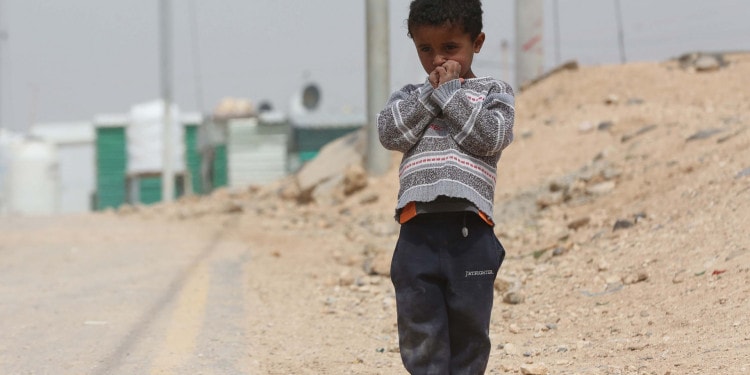Twenty-eight million children have been driven from their homes by violence and conflict within and across borders since 2016. Children make up about a third of the global population but about half of all refugees. In 2015 the number of children who applied for asylum unaccompanied was over 100,000. The same number if every child in a city the size of Boston were to do so.
“It’s easy to get gloomy or apathetic,” remarked Alice Vincent, senior security consultant at Arup, as we sat down to discuss her research. “The scale of the problem can make you feel helpless,” but even so, she has been trying to apply tried and tested design strategies to contribute to improving camps.
Armed with design experience and a desire to problem-solve at a structural level, Alice found where design and scale were most pressing was the ever-expanding and impromptu spaces of refugee camps.
For these camps, the first problems with design are the budgetary and time-constraints created by the unpredictable and often massive nature of refugee exoduses. And the second, compounded by the first, is the fierce battle between refugees and governing authorities about what level of permanence or impermanence should define refugees themselves and the structures they need.
These problems force designated authorities into services that focus on short-term “bottom line needs.” Needs that current methods of design and construction of camps have failed to confront, creating an insecurity that prevents the fulfilment of any secondary needs.
Look no further than the longest running refugee camps in the world, located in The West Bank/Palestine. In studying The Balata Refugee Camp, Dr. Abdellatif Qamheih documents how the structurally limited and rushed response to each of the four waves of Palestinian refugees created disorganized structures ill-suited to future expansion or long-term accommodation.

To make matters worse, the insecurity created from these oversights in design is most prevalent for marginalized groups. Whilst low reporting and difficult conditions to collect data make exact assessments difficult, anecdotal evidence suggests sexual violence and domestic violence are regular occurrences, with the victims often being women and children. Already considered at-risk groups, the de-prioritization of non-emergency services, like schools, latrines, and laundries, means it is at the outskirts of refugee camps where these groups are concentrated, leaving them increasingly vulnerable.
As such many of these problems have remained and many of the solutions included in Dr. Qamheih’s work, to create defensive spaces for these groups, have been passed over. Given the budgetary constraints and human risk involved in field-testing new approaches for humanitarian groups this is somewhat unsurprising. What has given these ideas new life has been their use by design firms like Arup.
Despite scepticism among some NGOs toward private sector involvement in humanitarian issues, Alice remarked that her experience working on these issues in “NGOs can feel a little powerless as you’re always relying on government, people, or donors to support your work.” A view that has been quietly gaining popularity, particularly among young people, but also that has been a constant in a few companies, like Arup.
In 1970, and long before it was the norm, Ove Arup delivered a speech in which he laid out both the aims and overall philosophy that he believed his private construction and design firm should stick to. What became known as Arup’s “Key Speech” emphasized that what work the firm does shouldn’t be needlessly profiteering but instead “should be interesting and rewarding.” Something that he believed could only be achieved through creating quality design throughout a society, a “total architecture” in which any project was in “harmony with the surroundings.”

Herein lie Arup’s driving values. Values that lead it into humanitarian work and whose source demonstrates a genuineness lacking in new-age “woke capitalism.” They led to the creation of Arup University, an initiative designed to allow its employees to explore design opportunities outside of their normal practise. Alice explained the shared benefits of this program, which allow employees creative control and expression whilst simultaneously building skills and “getting better at what you do” for the company.
It is through Arup university that Alice was able to explore how passive security measures applied on urban projects in London could be applied in camps. This new application of design measures to a very different context is not only garnering the interest of humanitarians but also of criminologists, whose work forms the basis of this theory.
Crime Prevention Through Environmental Design, or CPTED, is a passive crime prevention strategy used in urban contexts. It looks at how the social and built environment influences a potential offender’s decision to take criminal action.
Whilst these principles are still to be put to practise in refugee camps, the benefits proposed by a number of academics make a strong case. One of these benefits being that when compared to traditional “hardening measures,” CPTED offers less expensive solutions more suited to the camp setting. Rather than increasing community engagement, these traditional hardening methods of fencing and high-tech surveillance tend to only build feelings of isolation and insecurity. CPTED inspired solutions, detailed below, work actively to avoid these fortifications and the ensuing divisions, without requiring similar maintenance costs or political costs that come with the threat of permanence.
Theoretically, CPTED solutions are capable of being affixed to existing camp environments but their real potential lies in their use during the initial design of camps. If brought in at this early stage its benefits multiply, since its foundational ideas can be applied to create expansions accommodating new arrivals, and its methods don’t require significant upkeep when used over time.
What Would CPTED in Camps Look Like?
| Targeted Area | Method | Output | Proposed Effect |
| Decrease risk of opportunity to offend | Creation of community spaces/territoriality | Designing camp cul-de-sacs and creating house/street numbers | Dual effect of reducing points of entry to communities and bringing communities together over common ownership/identifying with a location |
| Increase risk of being caught | Creation of natural surveillance/connectivity | Constructing communal spaces, like sports fields built by homes throughout a camp | Dual effect of vulnerable people’s spaces (laundry, homes) being monitored by many people, and families being able to monitor vulnerable people (children) on sports field. |
| Increase difficulty of committing crime | Target hardening | Integrating locks on latrines and private homes | Increases difficulty of entry into private space and reduces stress by augmenting sense of privacy for families and individuals |
*https://research.arup.io/story/child-friendly-by-design
One example of this is how its design advocates the creation of cul-de-sacs to avoid the creation of outskirt communities populated by new arrivals who aren’t accounted for in the existing gridded designs. Having witnessed these first-hand, Alice states how “militaristic and unnatural those grids look.” A sentiment supported by research that details how reforming these structures into cul-de-sacs supports the building of communities and a sense of ownership not provided by these grids.
In circumstances as complex as these, no theory is without its weaknesses, something Dr. Qamheih acknowledges in his earlier mentioned study on the Balata Refugee Camp. One is the issue of cultural sensitivity as CPTED as a theory was developed in purely Anglo-American settings and would need to be reproduced primarily in countries of the Global South.
Another term for the cultural sensitivity Dr. Qamhehih mentions might be paternalism. CPTED’s prescriptive nature makes it all the more susceptible to these critiques as its rigidity creates the incentive to apply it as a brash cookie-cutter model which does not naturally seek input from local actors or its users.
A second line of criticism comes from those who broadly oppose practises or theory, like CPTED, that rely on trying to change or “nudge” human behaviour. Although some of CPTED’s solutions provided above are exempt from these critiques, some aren’t and particularly those that focus on surveillance.
Evgeny Morozov, a chief opponent of nudging and a researcher on the social implications of technology claims the cornerstone of nudging theory is that “while we behave irrationally, our irrationality can be corrected – if only the environment acts upon us, nudging us towards the right option.”
Amidst the rise of nudging as a practise within public policy, two clear problems have emerged which would relate to CPTED. One is the opacity in both the creation and implementation of nudges which assumes that those in the authority know best and that they have prepared for any ill-effects these changes might have.
Related Articles: A Life Dedicated to Refugees: Interview with Kelly Clements | How an Approach to Fighting Poverty Is Transforming the Way Refugees Experience Displacement
The other is that nudging focuses too much on the environment rather than the individual. Instead of asking why an individual would be forced into crime in the first place, it theorizes that all people have a propensity for crime, and it is the level of opportunity for crime which demarcates an individual’s criminal willingness. This shows a distinct trust of the individual and explains why CPTED is so firmly in support of greater surveillance, even in a non-specified catch-all manner.
Both its emphasis on surveillance and inability to course correct are evident in the translation of some of CPTED’s principles into “broken window” policing strategies, implemented most aggressively in New York during the 1990s. Whilst some credited these methods with crime reduction, the privacy violations and surveillance of “Stop and Frisk” policies led unintended widespread racial profiling and rising incarceration rates. And what is more worrying is that these unintended consequences have not prevented reiterations of these policing methods, which still rely on the same flawed concepts, like predictive policing.
Richard Thaler and Cass Sunstein, co-authors of the bestseller “Nudge: Improving Decisions about Health, Wealth, and Happiness” are some of those who continue to offer vigorous defenses of nudging against its critics.
Their argument is that nudging can provide an alternative to strict mandates, which expressly remove individual choice. With correct implementation, nudging can create the same positive results whilst preserving an individual’s freedoms, and also be more easily reversed and even ignored if either individuals or authorities recognize unintended side-effects. However, these arguments fail to account for the failures of Broken Windows policing, or worse, offer indifference to it.
As it relates to our question of using CPTED in the context of refugee camps, nudging’s critiques offer interesting observations but without concomitant solutions. Norway-based researchers Simon Reid-Henry and Ole Jacob Sending write that “Here, as elsewhere, questions of insecurity are often framed as a problem requiring a concomitant solution drawn from the toolbox of security, thus excluding from view questions of vulnerability, political exclusion or socioeconomic inequalities.”
Despite these legitimate concerns with CPTED, it still seems clear that some of its prescriptions might be an improvement on the status-quo. The criticism offered targets an interpretation of CPTED that even authors of The Broken Windows policing believe was stretched beyond its original intent. And when looking through its prescriptions for refugee camp design, it is difficult to see many of these criticisms fully borne out.

Where the criticisms are correct is that solving issues of inequality and exclusion in refugee camps should be given more weight in their design. This could be through the creation of local market economies or the provision of skills training and workshop areas.
However, any implementation of these grand plans brings us back to some of the original problems inherent in refugee camp design, for which conventional efforts at solving have failed and CPTED was designed to help. The lack of funding, driven by an unwillingness to create long-term investment into a “short-term” solution. These factors will still make CPTED’s cheaper and less permanent solutions a tempting one for camp authorities, despite its imperfections
Given that some aspects of it will likely be green-lit going forward, its critics of CPTED might at least be able to offer help in removing its paternalistic and indiscriminate drawbacks. One such reform would be to create these practises in tandem with camp inhabitants, a point that has not gone unrecognized in Arup’s decision to partner with INGOs on this project who can offer specific knowledge and access to camp residents able to offer their feedback.
When discussing this with Alice, she reminded me that these are early days both for this project and the application of this theory, which is months if not years from being tested. She also noted that if she thinks outside the realism of CPTED, she too would want a change to the philosophy of camps. Places “not referred to as camps, but as campuses” where non-refugees might seek to live in a small self-sufficient economy that utilise the underappreciated skills of refugees.
These kinds of ideas and experimentation take incredible time and energy to implement. And yet, seeing the energy and passion behind these ideas I can’t help but be reminded of a few words from a speech given nearly half a century ago, that has done much to inspire one firm’s work for the common good.
There are also two ways of looking at the pursuit of happiness: One is to go straight for the things you fancy without restraints, that is, without considering anybody else besides yourself. The other is to recognise that no man is an island, that our lives are inextricably mixed up with those of our fellow human beings, and that there can be no real happiness in isolation.











